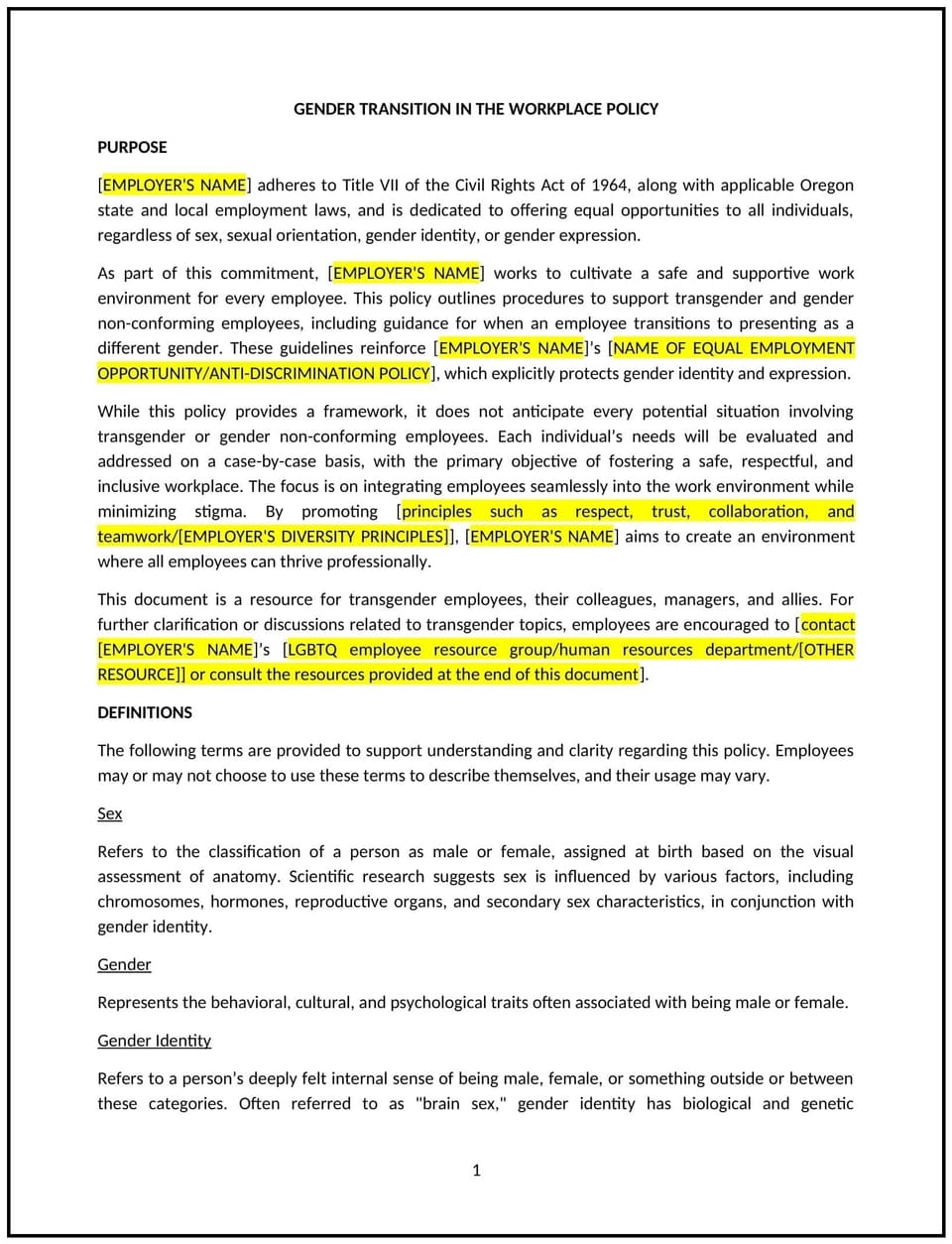Gender transition in the workplace policy (Oregon): Free template

Gender transition in the workplace policy (Oregon)
This gender transition in the workplace policy is designed to help Oregon businesses create a supportive and inclusive environment for employees undergoing gender transition. It outlines procedures for accommodating transitions, ensuring confidentiality, and promoting respect and dignity in the workplace.
By adopting this policy, businesses can foster inclusivity, reduce discrimination, and align with Oregon’s anti-discrimination laws.
How to use this gender transition in the workplace policy (Oregon)
- Define gender transition: Explain what gender transition entails, including social, medical, and legal aspects.
- Establish support procedures: Outline steps for employees to request accommodations, such as name changes, pronoun usage, or restroom access.
- Ensure confidentiality: Provide guidelines for protecting the privacy of employees undergoing gender transition.
- Promote respect and dignity: Encourage a workplace culture of inclusivity and zero tolerance for discrimination or harassment.
- Train employees and managers: Educate teams on gender diversity, transition processes, and their responsibilities under the policy.
- Monitor compliance: Regularly review workplace practices to ensure adherence to the policy.
- Update regularly: Assess the policy annually to align with evolving business needs and societal expectations.
Benefits of using this gender transition in the workplace policy (Oregon)
This policy offers several advantages for Oregon businesses:
- Fosters inclusivity: Demonstrates a commitment to supporting employees of all gender identities.
- Reduces discrimination: Helps prevent harassment and discrimination against transgender employees.
- Aligns with legal standards: Promotes compliance with Oregon’s anti-discrimination laws.
- Enhances employee satisfaction: Creates a positive workplace culture where employees feel valued and respected.
- Attracts diverse talent: Encourages applicants from diverse backgrounds to join the business.
Tips for using this gender transition in the workplace policy (Oregon)
- Communicate the policy: Share the policy with employees and include it in the employee handbook.
- Provide training: Educate employees and managers on gender diversity and transition processes.
- Use inclusive language: Ensure all communications and documents reflect respect for gender identity.
- Monitor compliance: Regularly review workplace practices to ensure adherence to the policy.
- Update regularly: Assess the policy annually to align with evolving business needs and societal expectations.
Q: How does this policy benefit businesses?
A: This policy helps businesses foster inclusivity, reduce discrimination, and align with Oregon’s anti-discrimination laws.
Q: What accommodations can employees request during gender transition?
A: Employees may request name changes, pronoun usage, restroom access, or other accommodations to support their transition.
Q: How should businesses handle confidentiality during gender transition?
A: Businesses should protect the privacy of employees undergoing transition and only share information with their consent.
Q: What should businesses do if an employee experiences discrimination?
A: Businesses should investigate complaints promptly, take corrective action, and ensure a supportive environment for the employee.
Q: How often should businesses review this policy?
A: Businesses should review the policy annually or as needed to align with evolving business needs and societal expectations.
This article contains general legal information and does not contain legal advice. Cobrief is not a law firm or a substitute for an attorney or law firm. The law is complex and changes often. For legal advice, please ask a lawyer.


